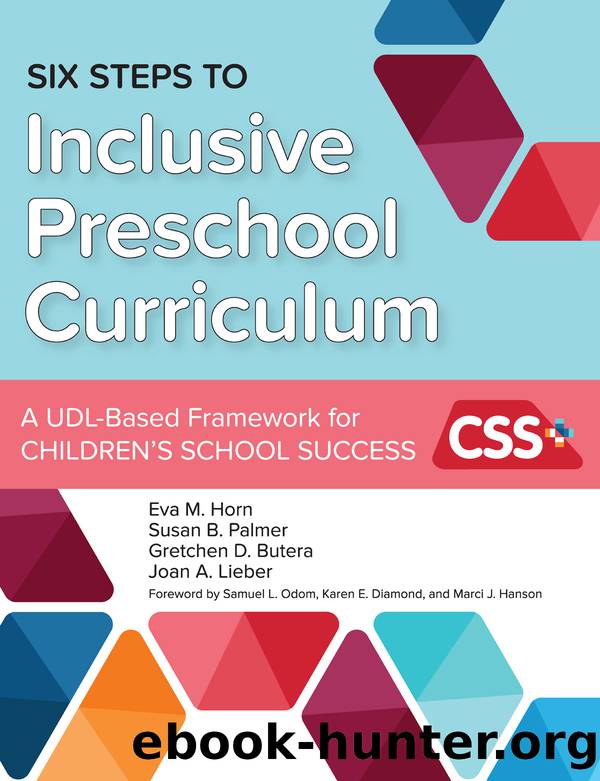Six Steps to Inclusive Preschool Curriculum by unknow

Author:unknow
Language: eng
Format: epub
Tags: EDUCATION / EDU048000 - Inclusive Education, EDUCATION / EDU023000 - Preschool & Kindergarten, EDUCATION / Teaching Methods & Materials / EDU029000 - General
Publisher: Brookes Publishing
Published: 2016-03-15T00:00:00+00:00
The GAS (Kiresuk et al., 1994) provides an individualized approach to monitoring a specific childâs progress that is based on input by the team. A goal that will be addressed in instruction can be chosen and a five-step rubric of observable learning steps that indicate a parallel or stepwise goal progress on the specific goal can be collected. The teacher and his or her team can rate the GAS at the end of a period of time predetermined by the complexity of the goal and the perceived ability of the child (Dinnebeil, Spino, & McInerney, 2011). Results can be shared with team members, including a parent or therapist, and provide a unique progress monitoring tool for teachers to use either with children who have IEP goals or a specific learning need in academic or social areas. A sample GAS template is provided in Appendix 7B.
As a team develops an IEP goal for a particular child, the GAS (Kiresuk et al., 1994) process supports discussion about the related increments of achievement levels toward that goal that might be expected within a 6- to 8-week period. Families and educators can discuss the five levels of possible outcomes on the GAS related to a specific goal in order to effectively use this measure. Knowing the child, the ability of the child related to a particular goal or learning objective, and the specifics of the instructional setting are helpful when scaling the rubric. Steps for using the GAS to focus on one childâs learning or social skills might include the following:
1.Choose one achievement or social skill need to address that already exists (IEP goal for children with disabilities) or an ongoing learning or social challenge you have observed in the classroom for a particular child.
2.Think about how the identified need can be addressed for this child by talking with team members, colleagues, and family members, if possible.
3.Draft the goal in active language on which the GAS will be based. For example, phrase the goal in words that describe an observable, achievable action or set of skills such as, âJane will learn to identify 10 of the 26 lowercase letters of the alphabetâ (see Figure 7.6). It is best to avoid stating a goal in indirect or negative terms such as, âSam will not get up during circle time and run around the classroom.â Instead, a goal for Sam could be the number of increased minutes that he can attend during circle time with a fading number of prompts (see Figure 7.7).
4.Choose the setting that will be used with the goal. This may be a typical classroom routine such as entering the classroom from the bus, moving in and out of centers, or during math small group or literacy large group. Goals can be targeted for measurement in one setting and later generalized to additional places or situations.
5.Think through the type of strategies to be used for instruction related to a childâs goal. You may specify prompts, scripted stories about the child using child photos, positive reinforcement, and other possible teacher strategies.
Download
This site does not store any files on its server. We only index and link to content provided by other sites. Please contact the content providers to delete copyright contents if any and email us, we'll remove relevant links or contents immediately.
| Behavioral Disorders | Communicative Disorders |
| Gifted Students | Inclusive Education |
| Learning Disabled | Mentally Disabled |
| Physically Disabled |
The Art of Coaching Workbook by Elena Aguilar(50963)
Trainspotting by Irvine Welsh(21517)
Twilight of the Idols With the Antichrist and Ecce Homo by Friedrich Nietzsche(18501)
Fangirl by Rainbow Rowell(9093)
Periodization Training for Sports by Tudor Bompa(8168)
Change Your Questions, Change Your Life by Marilee Adams(7633)
This Is How You Lose Her by Junot Diaz(6778)
Asking the Right Questions: A Guide to Critical Thinking by M. Neil Browne & Stuart M. Keeley(5630)
Grit by Angela Duckworth(5512)
Red Sparrow by Jason Matthews(5390)
Paper Towns by Green John(5086)
Room 212 by Kate Stewart(5035)
Ken Follett - World without end by Ken Follett(4643)
Housekeeping by Marilynne Robinson(4328)
The Sports Rules Book by Human Kinetics(4288)
Double Down (Diary of a Wimpy Kid Book 11) by Jeff Kinney(4204)
Papillon (English) by Henri Charrière(4195)
The Motorcycle Diaries by Ernesto Che Guevara(4009)
Exercise Technique Manual for Resistance Training by National Strength & Conditioning Association(3955)
